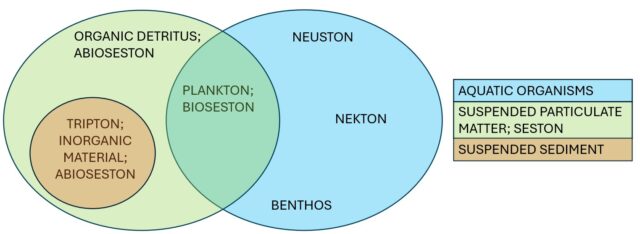A melting pot
Researchers in oceanography come to the field from all sides: physicists, biologists, geologists, geographers, hydrologists, mathematicians and many more. As a result, there can be a confounding number of terms for the same thing. An example of this is how we name the various components of suspended particulate matter (SPM) in the aquatic environment.
For starters, a synonym for SPM, particularly amongst biologists, is seston. SPM makes up all particulate matter suspended in the aquatic environment, regardless of its origin – e.g., organic or inorganic – and regardless of whether the particles are dead or alive. Terrestrial erosion, photosynthesis, and the formation of biogenic carbonate (Ca-based shells) and biogenic opal (Si-based shells) supply the particles that make up the SPM.
A part of SPM consists of living organisms such as plankton, also referred to as bioseston. Note that plankton is a subsection of all aquatic organisms with Neuston, Nekton and Benthos broadly making up the rest of the aquatic organisms. Plankton distinguishes itself by not being able to move around in the water, at least not against the prevailing currents. In that sense it is like a suspended sediment grain derived from terrestrial erosion.
When plankton dies, it decays and contributes to the abioseston, either as organic detritus or as Tripton, which consists of all the inorganic suspended particulate matter. But note that inorganic matter can have an organic origin, e.g., the external shells of dead foraminifera.
Biologists vs Geologists
Note that detritus has hugely different meanings for, e.g., a biologist and a geologist: For biologists, detritus is organic designating dead and decaying organic matter. To geologists, detritus refers to particles, minerals, or rock fragments from eroded or weathered pre-existing rocks – picture:
Coastal oceanographers in areas with high terrestrial SPM, like estuaries, often refer to all SPM as suspended sediment.
The Venn Diagram is an attempt to show the origin of the diverse types of suspended particulate matter. It is not meant to be authoritative or final. As mentioned earlier, your background may shape strong views on this.

Van Venn diagram showing the relationship between Suspended Particulate Matter and Aquatic Organisms.
